Updated: AOpen MiniPC – Imitation is the Sincerest Form of Flattery
by Jarred Walton on March 3, 2006 12:05 AM EST- Posted in
- Systems
Installation and Setup
The installation and setup process for the MiniPC is really a tale of two extremes. AOpen shipped us a pre-built unit, so all I had to do was plug it in, connect an appropriate keyboard and mouse, and it was ready for use. That's how every one of these systems should be sold, because frankly, stuffing the necessary parts into a case this small is going to be a difficult task for most people. Popping open the unit shows just how much room you have to work with, and we would much rather leave the task of putting the computer together to the people on the assembly line. If you have really large hands, if could be difficult, though really having the right tools is the most important part of working with the case.
Four screws underneath the non-slip pad secure the case, and removing them is pretty simple. Once that's done, opening the case still requires some effort, as the top and bottom snap together. After you (carefully) pry it open, you can see the internals, which are packed with all of the required parts. The process of pulling the top and bottom apart is definitely not easy, and given the presence of four screws to hold the two halves together, we would prefer to use less force. All the little metal "teeth" around the sides appear to add a lot of pressure so that even without the screws the top and bottom are in no danger of separating. The metal prongs can also scratch the sides if you're not careful when pulling the case apart or putting it back together.
The motherboard has a single DDR2 SO-DIMM slot, a Mini-PCI slot that is filled with a wireless networking device in some configurations (our unit didn't have WiFi), and a heat sink and fan unit that covers both the CPU and the chipset. It would have been nice to get a second SO-DIMM slot for memory expansion, and most laptops have memory access panels underneath a small hatch to make RAM upgrades easy and quick. That's something for Aopen or their competitors to consider for future designs.
While the HSF is quite small and would certainly be inadequate for cooling higher power CPUs, the 22W TDP Pentium M does perfectly well, and the case under full load was only slightly warm - just like a typical laptop.
The top of the unit has a plastic cage that holds the 2.5" HDD and the slim optical drive. Removing four more screws and a bit more prying gets that out of the way, at which point you can install the HDD and optical drive. Note that the optical drive is a standard laptop form factor, but a slot-loader drive is required. AOpen makes such drives in either a CD-RW/DVD-ROM combo unit or a standard DVD+/-RW drive. A proprietary PCB converts the IDE interface into a connection that slots into the motherboard (which incidentally also helps to hold the top and bottom of the case together). The card then plugs into the connections on the optical drive and HDD - think of it as a solid, compact replacement for the typical ribbon cable.
In the above images, you can also see that there is a built-in speaker that functions as a mono audio output. It isn't very loud and the quality is what you would expect from the size, not to mention that it's concealed behind a metal cover. It will be sufficient for hearing the Windows sound events and listening to audio files where high fidelity isn't a requirement - basically enough for a business environment.
The installation and setup process for the MiniPC is really a tale of two extremes. AOpen shipped us a pre-built unit, so all I had to do was plug it in, connect an appropriate keyboard and mouse, and it was ready for use. That's how every one of these systems should be sold, because frankly, stuffing the necessary parts into a case this small is going to be a difficult task for most people. Popping open the unit shows just how much room you have to work with, and we would much rather leave the task of putting the computer together to the people on the assembly line. If you have really large hands, if could be difficult, though really having the right tools is the most important part of working with the case.
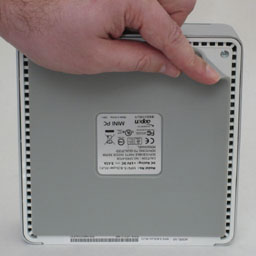 |
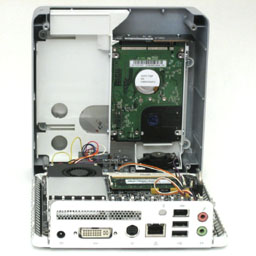 |
| Click on images to enlarge. | |
Four screws underneath the non-slip pad secure the case, and removing them is pretty simple. Once that's done, opening the case still requires some effort, as the top and bottom snap together. After you (carefully) pry it open, you can see the internals, which are packed with all of the required parts. The process of pulling the top and bottom apart is definitely not easy, and given the presence of four screws to hold the two halves together, we would prefer to use less force. All the little metal "teeth" around the sides appear to add a lot of pressure so that even without the screws the top and bottom are in no danger of separating. The metal prongs can also scratch the sides if you're not careful when pulling the case apart or putting it back together.
 |
 |
| Click on images to enlarge. | |
The motherboard has a single DDR2 SO-DIMM slot, a Mini-PCI slot that is filled with a wireless networking device in some configurations (our unit didn't have WiFi), and a heat sink and fan unit that covers both the CPU and the chipset. It would have been nice to get a second SO-DIMM slot for memory expansion, and most laptops have memory access panels underneath a small hatch to make RAM upgrades easy and quick. That's something for Aopen or their competitors to consider for future designs.
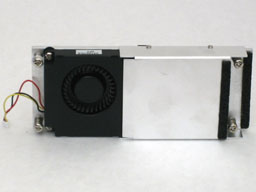 |
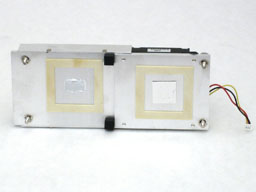 |
| Click on images to enlarge. | |
While the HSF is quite small and would certainly be inadequate for cooling higher power CPUs, the 22W TDP Pentium M does perfectly well, and the case under full load was only slightly warm - just like a typical laptop.
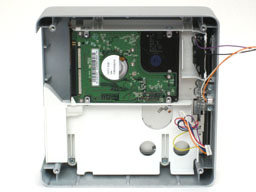 |
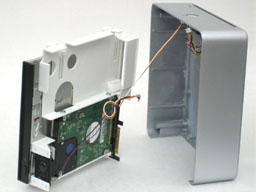 |
| Click on images to enlarge. | |
The top of the unit has a plastic cage that holds the 2.5" HDD and the slim optical drive. Removing four more screws and a bit more prying gets that out of the way, at which point you can install the HDD and optical drive. Note that the optical drive is a standard laptop form factor, but a slot-loader drive is required. AOpen makes such drives in either a CD-RW/DVD-ROM combo unit or a standard DVD+/-RW drive. A proprietary PCB converts the IDE interface into a connection that slots into the motherboard (which incidentally also helps to hold the top and bottom of the case together). The card then plugs into the connections on the optical drive and HDD - think of it as a solid, compact replacement for the typical ribbon cable.
In the above images, you can also see that there is a built-in speaker that functions as a mono audio output. It isn't very loud and the quality is what you would expect from the size, not to mention that it's concealed behind a metal cover. It will be sufficient for hearing the Windows sound events and listening to audio files where high fidelity isn't a requirement - basically enough for a business environment.










54 Comments
View All Comments
bldckstark - Saturday, March 4, 2006 - link
Maybe lots and lots of people do care, but I couldn't give a crap less about what the back panel of any computer looks like. Maybe someone could tell me why they do.As for it not looking better, that would be a subjective opinion.
Snuffalufagus - Saturday, March 4, 2006 - link
Just for the sake of the 'Company that sucks' copied the 'company that had the idea first' argument, what, in a low profile box, of the same approximate dimensions, could they have done to make people not claim it was a duplicate? Change the color? Change the rubber foot pads? Revert back to PS2 connections? This idea that one company shouldn't build off the strengths found in another is stupid, and would ultimately lead to stagnation if no company learned from the mistakes and successes of another.Copying form doesn't really mean shit as far as one being better. Hell, I think the Mac Mini is a piece of crap due to it's lack of versatility, but now its being praised for that capability now that this new piece of crap is out (i.e. two vs. one mem slot).
FWIW - this wasn't purely a response to your post, it was just a covenient place to put the comment.
JarredWalton - Saturday, March 4, 2006 - link
I couldn't care less about copying. Whoever does it best gets my vote. The lack of versatility really isn't a major lack, though. The only things the MiniPC can't do are:1) Gaming (other than old games or 2D stuff)
2) High-end audio (without USB add-on)
3) TV Tuner stuff
4) High performance computing.
Most people don't need any of those things. Given that it's small, reasonably fast, and reasonably quiet (and all of the above pretty much applies to the Mac Minis as well), these things could be great for the less power hungry people.
Unfortunately, my mom still can't use a computer worth a darn, so reducing hardware complexity isn't going to help her with the software side. (And please don't bother suggesting OSX; she really is clueless about computers, and we're just happy when she can manage to read/write email!)
Herrterror - Friday, March 3, 2006 - link
yeah, poor Apple. They wanted to introduce Sloanism to the computer industry and ended up losing out to copycats.kmmatney - Friday, March 3, 2006 - link
The price of this has to be at least lower than a laptop. You can get a decent laptop for the same price, with a built-in LCD and Keyboard, and a lot more IO. You can still just hook up a Keyboard and Monitor with a laptop, as I do at work everyday, plus you get portability if you need it.JarredWalton - Saturday, March 4, 2006 - link
A few things laptops are generally lacking:1) DVI output
2) Component output
3) Anything more than 2.1 audio output
So, the HDTV connections of the MiniPC are definitely something to think about. Component out is probably the best way to guarantee a system can function as an HTPC (though the whole HDCP issue is looming on the horizon....) Also, these systems (Mac Mini/MiniPC) are both smaller than a laptop - why have a screen if you're not going to use it, right? But I do agree that the price needs to at least match an equivalent laptop.
WhoBeDaPlaya - Monday, March 6, 2006 - link
The Audigy 2 ZS PCMCIA has #3 covered ;)Been using it with my trusty 'ol eMachines m6805 since late 2004.
Snuffalufagus - Friday, March 3, 2006 - link
but fill a particular niche market that's appealing for certain applications.joey2264 - Friday, March 3, 2006 - link
I was just thinking ... what if they did an end run around apple by making this a dvr? Apple's stupid allegiance with the content providers practically guarantees they will never put out a true dvr, but aopen obviously has no such qualms. They need to make a version with core duo, decent tv tuner built-in(preferably ati 550 pro if that was possible), 2 ram slots, at least 4 usb ports, and spdif (basically the same ports as the mac mini + a tv in).How cool would that be? It might even put the pressure on apple to produce a dvr of their own.
joey2264 - Friday, March 3, 2006 - link
I think the key thing here, the reason why Apple can charge such a low price, is because you are not paying for the os with the mac mini. This price advantage does not factor itself into every other Apple product, because of Apple's crazy profit margins. But this is the one product where they are willing to make little to no profit, and so, who whodathunkit, they are price competitive. If only they would take a similar strategy (although obviously not to this extreme) with their other products).The only way the wintel world could compete is if Microsoft designed a mini pc of their own, or gave it away to an extra special favorite manufacturer of theirs.